Scottish Agricultural Tenure Evidence Review
A review of tenure arrangements in Scotland and case studies of selected countries
4 Analysis Of Land Tenure Data
Trends in Scotland's Tenanted Land
4.1 Figure 3 shows the long term trends in the proportion of owned land and land under all tenure arrangements (including crofts) in Scotland, along with some key policy and legislative timelines. In 1982 let land accounted for 40.5% of Scottish land and in the decade to 1991 it fell gradually to 38.5% of land area. In the period following the Agricultural Holdings (Scotland) Act 1991 and the McSharry reforms of the Common Agricultural Policy (CAP) the rate of decline in let land increased, falling to 29.9% of total land in 2004. The enactment of the Agricultural Holdings (Scotland) Act 2003 and the decoupling of CAP support and the introduction of the Single Farm Payment closely coincided at the end of 2004 and by 2013 the area of let land fell to just over 24% of agricultural area.
4.2 These changes represent a 42% decrease in the area of let land from 1982, a 37% decrease since 1991 and a 17% decrease since 2004. This trend is not just about agricultural holdings legislation since the increased decoupling of CAP support since 1992 (arable aid payments were made on a per hectare basis as was set-aside) has clearly a part to play in incentivising greater control over farmland in order to benefit from CAP support payments. This incentive is likely to have increased since 2005 given the introduction of the Single Farm Payment which required the farmer to comply with statutory management requirements rather than actively farm the land.
Figure 3 Proportion of owned and rented agricultural land, 1982-2013
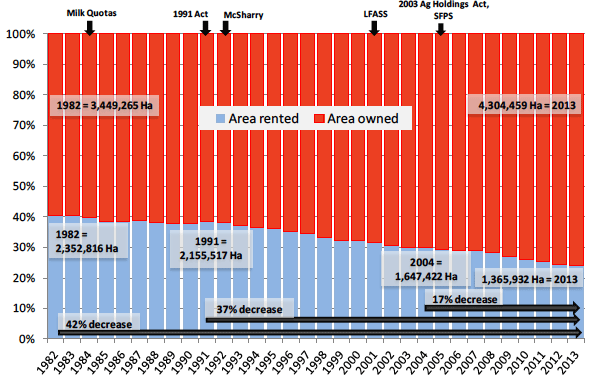
Data Source: Abstract of Scottish Agricultural Statistics 1982-2013[3]
Let Land - Excluding Croft Holdings
Total Rented Land (excluding seasonal lets)
4.3 Table 4 shows the trend in the proportion of holdings renting land under agricultural tenure arrangements and the proportion of total agricultural land being let under these arrangements (no seasonal lets are included), once croft holdings have been excluded. This shows that once identifiable crofts have been removed that the number of holdings renting land under agricultural tenure arrangements (excluding seasonal lets) fell from 24.4% in 2000 to 17.4% in 2013 whilst the total area of land under these leases fell from 30.6% to only 22.2% of land over the same period. There were large regional variations in both the proportion of holdings and the proportion of land that was rented under tenure arrangements (see Table 15 in Annex A), with very low levels in Orkney and much higher levels in Tayside, the Borders, Dumfries and Galloway and in the crofting counties.
Table 4 Proportion of agricultural land (excluding crofts) and holdings renting land 2000-2013
| Year | Renting Land | All land non-croft holdings and land | ||||||
|---|---|---|---|---|---|---|---|---|
| Area | Holdings | |||||||
| Hectares | % Total | Number | % Total | Hectares | Holdings | |||
| 2000 | 1,592,765 | 30.6% | 9,046 | 24.4% | 5,211,227 | 37,111 | ||
| 2001 | 1,571,286 | 30.1% | 8,845 | 23.7% | 5,223,491 | 37,245 | ||
| 2002 | 1,525,432 | 29.1% | 8,702 | 23.1% | 5,243,443 | 37,631 | ||
| 2003 | 1,493,334 | 28.6% | 8,476 | 22.4% | 5,224,252 | 37,817 | ||
| 2004 | 1,483,075 | 28.4% | 8,380 | 21.9% | 5,219,354 | 38,264 | ||
| 2005 | 1,449,847 | 27.8% | 8,257 | 21.4% | 5,223,751 | 38,567 | ||
| 2006 | 1,465,738 | 27.6% | 8,138 | 21.0% | 5,309,126 | 38,790 | ||
| 2007 | 1,444,306 | 27.3% | 7,919 | 20.4% | 5,287,881 | 38,830 | ||
| 2008 | 1,417,760 | 26.6% | 7,756 | 19.9% | 5,331,652 | 38,924 | ||
| 2009 | 1,355,957 | 25.2% | 7,613 | 19.5% | 5,376,499 | 39,138 | ||
| 2010 | 1,307,847 | 24.1% | 7,236 | 18.5% | 5,417,248 | 39,202 | ||
| 2011 | 1,279,002 | 23.7% | 7,128 | 18.1% | 5,398,885 | 39,391 | ||
| 2012 | 1,211,181 | 22.6% | 6,988 | 17.7% | 5,349,485 | 39,432 | ||
| 2013 | 1,190,015 | 22.2% | 6,875 | 17.4% | 5,354,629 | 39,506 | ||
4.4 It was evident that a high number of unidentified croft holdings remained within the dataset despite best efforts to remove them. Around 60% of (about 735) holdings in Eileanan an Iar were renting land[4] in 2013 and it is suspected that the issue of unidentified crofts within the dataset also existed to a lesser extent in Shetland, Highland and Argyll and Bute regions. Table 16 in Annex A reveals the regional variation at businesses (BRN) level, and again the high proportion of BRNs renting in the traditional crofting areas confirms that at a business level the likelihood is that the dataset contains a number of croft businesses.
4.5 Using business (BRN) level data that excludes identified crofts and holdings not registered with the Scottish Government for CAP support, Table 5 reveals that there were 22,354 registered non-croft BRNs in 2013 that accounted for 96% of total non croft land in Scotland (calculated from Table 4). The data shows that in 2009 26.8% of BRNs rented land, falling to 24% in 2013[5] with the total amount of land they rented falling from 26.4% in 2009 to 22.8% in 2013.
Table 5 Proportion of agricultural land (excluding crofts) and BRNs renting land 2009-2013
| Year | Renting Land | Total non-croft BRNs and land area | ||||||
|---|---|---|---|---|---|---|---|---|
| BRNs | Area | |||||||
| Number | % Total | Hectares | % Total | BRNs | Hectares | |||
| 2009 | 5,882 | 26.8% | 1,330,110 | 26.4% | 21,961 | 5,037,825 | ||
| 2010 | 5,578 | 25.3% | 1,281,134 | 25.1% | 22,046 | 5,105,671 | ||
| 2011 | 5,522 | 24.9% | 1,245,040 | 24.4% | 22,146 | 5,105,530 | ||
| 2012 | 5,470 | 24.6% | 1,191,724 | 23.3% | 22,255 | 5,108,534 | ||
| 2013 | 5,371 | 24.0% | 1,172,935 | 22.8% | 22,354 | 5,139,644 | ||
4.6 Figure 4 shows how the number of holdings that rent land fell by 24% across Scotland between 2000 and 2013, including 33.6% in Tayside, 29.8% in Highland and 28.1% in Ayrshire. Even in the areas traditionally associated with agricultural tenancy in the South of Scotland and the North East the number of holdings renting land fell by around a fifth (the Borders fell by 19%, with 18.8% decline in Dumfries and Galloway and 21.1% decline in the North East). Across Scotland the amount of land rented fell by 25% between 2000 and 2013, falling by 44.1% in Tayside (from 243,146ha to 135,857ha), 31.3% in the Highlands, 25.9% in Lothian and 25.32% in Ayrshire. There were low declines in the amount of land rented in East Central (8.5%), Orkney (12.7%) and the North East (14.2%) regions.
Figure 4 Change in number of holdings renting and area rented by agricultural region, 2000-2013
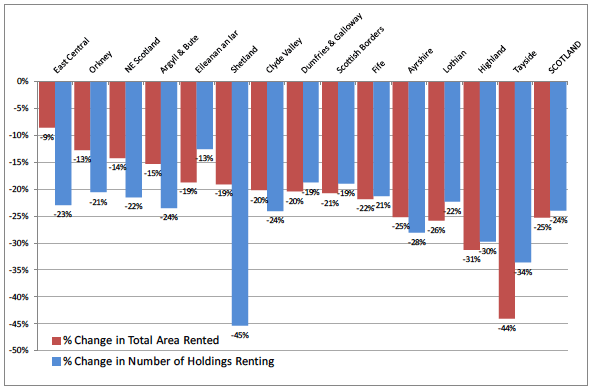
4.7 Figure 5 shows how the rate of change in the number of holdings and area rented across the regions differed through time. Generally there was a steady rate of decline in the number of holdings renting land over time with the exception of Shetland which saw a rapid decline after 2007 (perhaps as a consequence of improved identification of crofts). The fact that Eileanan an Iar, Shetland, Highland and Argyll and Bute all had the highest proportions of holdings renting land again suggests that perhaps a number of crofts remained within the dataset despite best efforts to remove them. There was greater variability in the rate of change in the area rented with, for example a steady decline in Tayside until 2011 with a sudden decrease in rented land in 2012. Orkney had relative stability in the amount of rented land, the Borders had steady decline until 2010 before stabilising, Dumfries and Galloway having straight line decrease, whilst in Highlands there was relative stability between 2002 and 2008, followed by four years of decline.
Figure 5 Proportion of holdings renting and area rented by agricultural region, 2000-2013
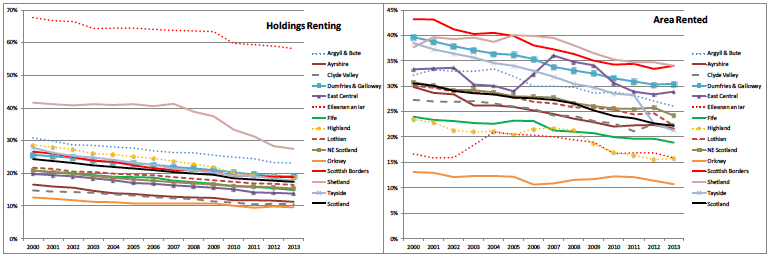
4.8 Figure 6 shows that at business level despite the number of BRNs falling by 7.5% in East Central region between 2009 and 2013 the amount of land rented by BRNs increased by 4.5%. This contrasted with Clyde Valley where despite only 5.9% fewer businesses renting land over the period the total area rented by BRNs fell by 23.8%. There were also large decreases in the area of land rented by businesses over this period in Tayside, Eileanan an Iar, Highland and Lothian with relative stability in Ayrshire, the Borders and Dumfries and Galloway. Table 16 in Annex A provides details of the regional number and proportion of BRNs renting land and the area that is rented. The business level data followed a similar pattern to holdings with only 13.4% of BRNs in Orkney renting land in 2013 (10.4% of the area) compared to 26.5% of BRNs in the Borders who rented 34.6% of the area and 25% of Dumfries and Galloway BRNs who rented 31.4% of the area.
Figure 6 Change in number of BRNs renting and area rented by agricultural region, 2009-2013
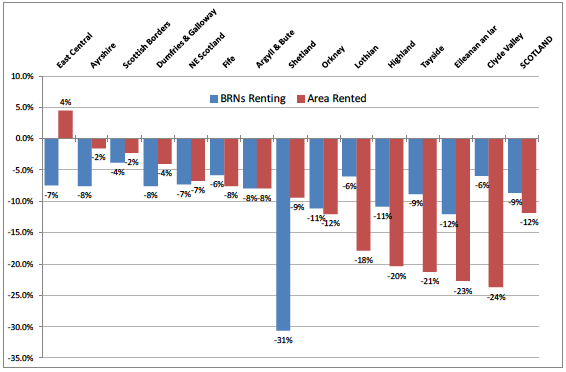
4.9 Variation in land tenure patterns by different size categories was also found (see Table 17 in Annex A for a summary of the data). Figure 7 shows that generally the likelihood of renting land under agricultural tenure arrangements (excluding seasonal lets) between 2004 and 2013 was positively correlated to holdings size (based on activity). Very small holdings were considerably less likely to rent land over the period. However, the proportion of land rented did not follow this pattern with a higher proportion of total land within the size category found to be rented by large holdings in comparison to the very large holdings (which were closely aligned to the medium sized holdings). The proportion of very large holdings that rented land fell from 43.6% in 2004 to 38.8% in 2013 (although this was only 44 holdings) with the area let falling from 678,532ha to 536,048ha (21% reduction). The proportion of large holdings renting land under agricultural tenure fell from 39.3% to 35%) over the period and the amount of land rented fell by (17.7%). The medium sized holdings had the largest reduction in the area let (31.3%) with the proportion of holdings renting land having fallen from 36.2% to 32.1%. 369 fewer small holdings rented land over the period amounting to 13,711 fewer hectares being rented (from 18.8% to 13.6% of the total land area of very small holdings).
Figure 7 Proportion of holdings that rent land and proportion of land rented, by size category: 2004-2013
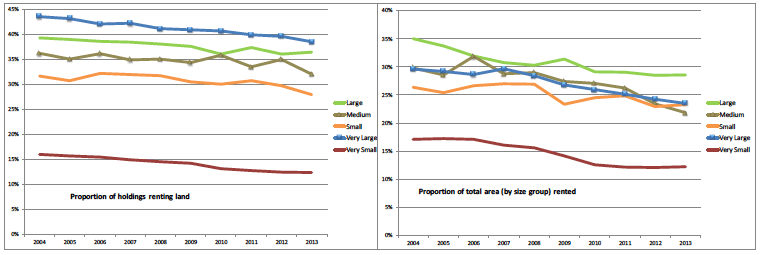
4.10 In addition to regional and holding size variations in agricultural tenure trends a difference between robust farm types (see Table 18 in Annex A for a summary) was also found although it should be acknowledged that holding movement between robust farm types may cloud the detail. Figure 8 does however show strong downward trends in the proportions of all robust farm types, with the exception of "other". There was very wide variance in the proportion of holdings that rented land in each robust farm type grouping with LFA cattle and sheep, dairy, general cropping, cereals and mixed holdings having a greater propensity to rent land than the other groupings which are perhaps more specialist (with the exception of "other"). There was a 30% decline in the number of LFA cattle and sheep holdings renting land between 2000 and 2013 with a 25.5% decrease in area rented over the period. The proportion of general cropping holdings renting land fell from 38% to 27.6% with a decrease in the proportion of land rented from 32.7% of total area to only 20.8% (a 33% reduction). Similar trends were observed across the main farming types where fewer holdings leased land with fewer hectares being rented. The large fluctuations in proportion of land rented in the pig, poultry and horticulture sectors (which were historically unsupported sectors and faced with fluctuating market returns) may relate to (a) reactions to performance cycles and (b) they were very few in number meaning percentage changes can appear very large due to the small starting base..
Figure 8 Proportion of holdings that rent land and proportion of land rented, by robust farm type: 2000-2013
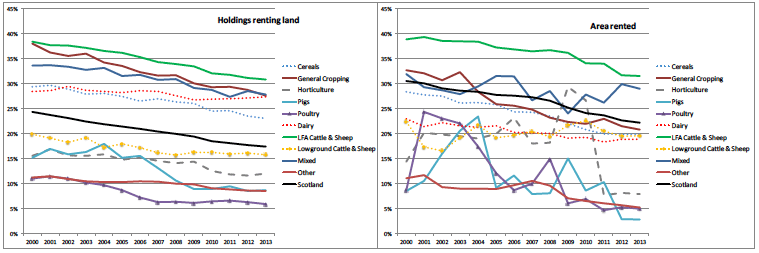
4.11 Figure 9 shows the geography of land tenure showing the proportion of non-croft land in each agricultural parish that was rented in 2000 and 2013. This reveals local concentrations of high levels of land rental similar to that published by the Scottish Government[6], and Andy Wightman has shown[7] that many of these high rental concentrations are found in areas where there are large traditional estate owners letting land. What Figure 9 reveals that previous published analysis does not is how the position has changed since 2000, when there was generally more land being rented across Scotland. At this level of detail it is evident that there has been significant reductions in the proportions of let land in some parishes, suggesting either (a) withdrawal from the tenancy market by landowners, (b) purchase of rented land by tenants, or (c) a combination of (a) and (b).
Figure 9 Proportion of non-croft holding land let under tenure arrangements by parish, 2000 and 2013
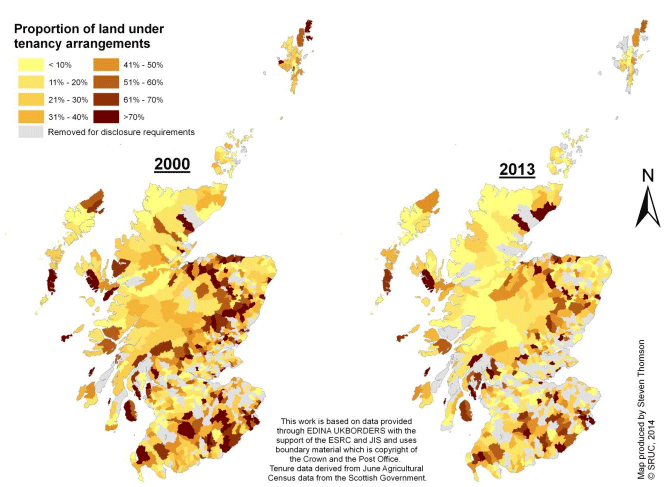
Tenure Mix
4.12 Using the time series of JAC data each holding was categorised as being fully tenanted, fully owned or with mixed tenure (partially owned and partially rented) for each year. Figure 10 highlights how the proportion of fully owned holdings increased from 75.6% in 2000 to 82.6% in 2013 with the proportion of total area being fully owned also increasing from 63.9% to 71.7% over the same period. The proportion of holdings under mixed tenure declined marginally from 6.3% to 5.4% with a small increase in the proportion of land rented (from 9.9% to 11.5%). The proportion of holdings that were fully tenanted fell from 18.1% in 2000 to 12% in 2013 with the proportion of land on these holdings falling from 26.2% to 16.9% of total non croft land.
Figure 10 Proportion of holdings and land under different tenure mixes, 2000-2013

4.13 Figure 11 shows that on average fully owned holdings were considerably smaller than fully tenanted holdings, which in turn were smaller than mixed tenure holdings (a gap that has widened since 2000). The size of fully owned holdings remained very stable over the period at about 115 hectares, with fully tenanted holdings falling from an average of 203ha in 2000 to 190ha in 2013. There was considerable growth in the average area of mixed tenure holdings, increasing from 219ha in 2000 to a high of 303ha in 2011 before falling back to 288ha in 2013.
Figure 11 Average size of holdings under different tenure mixes, 2000-2013
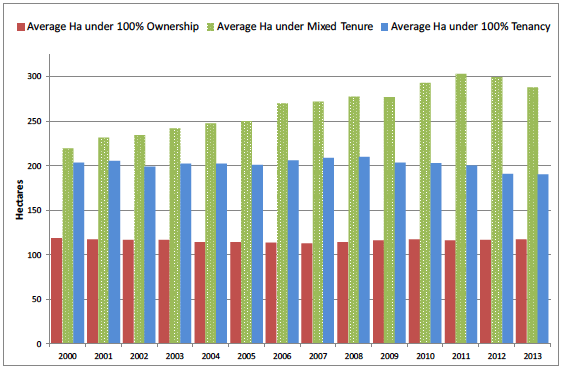
4.14 Table 6 shows that when the same analysis was conducted at BRN level that the average number of hectares controlled by each business increases dramatically from the holding level analysis. Mixed tenure businesses had on average twice as many hectares as wholly owned businesses and about 70% more than wholly tenanted businesses. This also revealed that mixed tenure businesses control a considerably larger proportion of the total farmed area (over 20%) than the holding level analysis suggested. The data also shows that it was estimated that in 2009 there were 3,331 wholly tenanted businesses (BRNs) controlling 879,588ha. It was estimated that this fell to 2,924 businesses in 2013, farming 731,366ha (declines of 13.9% and 20.3% respectively).
Table 6 Average structure of BRNs by different tenure mixes, 2009-2013
| Year | Measure | Wholly Tenanted | Mixed | Wholly Owned | |||
|---|---|---|---|---|---|---|---|
| 2009 | Total Area | 879,588 | 17.5% | 1,060,379 | 21.0% | 3,097,858 | 61.5% |
| BRNs | 3,331 | 15.2% | 2,550 | 11.6% | 16,080 | 73.2% | |
| Average Ha | 264 | 416 | 193 | ||||
| 2010 | Total Area | 838,758 | 16.4% | 1,043,212 | 20.4% | 3,223,700 | 63.1% |
| BRNs | 3,125 | 14.2% | 2,453 | 11.1% | 16,468 | 74.7% | |
| Average Ha | 268 | 425 | 196 | ||||
| 2011 | Total Area | 812,461 | 15.9% | 1,053,651 | 20.6% | 3,239,418 | 63.4% |
| BRNs | 3,059 | 13.8% | 2,463 | 11.1% | 16,624 | 75.1% | |
| Average Ha | 266 | 428 | 195 | ||||
| 2012 | Total Area | 753,056 | 14.7% | 1,043,797 | 20.4% | 3,311,681 | 64.8% |
| BRNs | 2,996 | 13.5% | 2,474 | 11.1% | 16,785 | 75.4% | |
| Average Ha | 251 | 422 | 197 | ||||
| 2013 | Total Area | 731,366 | 14.2% | 1,050,538 | 20.4% | 3,357,740 | 65.3% |
| BRNs | 2,924 | 13.1% | 2,447 | 10.9% | 16,983 | 76.0% | |
| Average Ha | 250 | 429 | 198 | ||||
4.15 Analysing the fully tenanted holdings by region reveals that rate of decline (the angle of slope) in the proportion of holdings that were fully tenanted was similar across all regions, with the exception of the crofting counties (as shown in Figure 12). 39.4% of the Borders area was on holdings that were fully rented in 2000, with corresponding figures of 34.2% in Dumfries and Galloway and 33.7% in Tayside. By 2013 these figures had fallen to 29.2%, 22.5% and 17.0% respectively highlighting large changes in regional tenure patterns that have occurred (average areas of fully tenanted holding were pretty stable across most regions - as shown in Figure 33 in Annex A).
Figure 12 Proportion of holdings and area that are fully under tenure arrangements, by region: 2000-2013
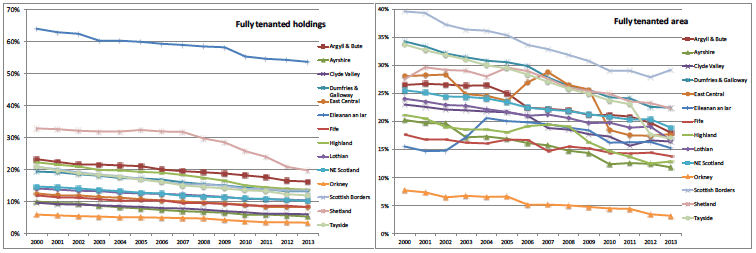
4.16 The spatial distribution of the proportion of land on fully tenanted holdings closely mirrors Figure 9 (see Figure 32 in Annex A) but there is an interesting spread of mixed tenure holdings locally, and the change since 2000 is worth considering. At parish level there were increases in areas such as the Kyles of Bute, Mull, the Trossachs, Loch Ness, and around Insch in Aberdeenshire. Regionally (see Figure 13) it is noticeable that there was a large shift in the proportion of mixed tenure businesses in the Trossachs and Orkney with smaller increases also witnessed in the South West, Argyllshire and Inverness and Nairn.
Figure 13 Proportion of land on mixed tenure holdings by NUTS IV region, 2000 / 2013
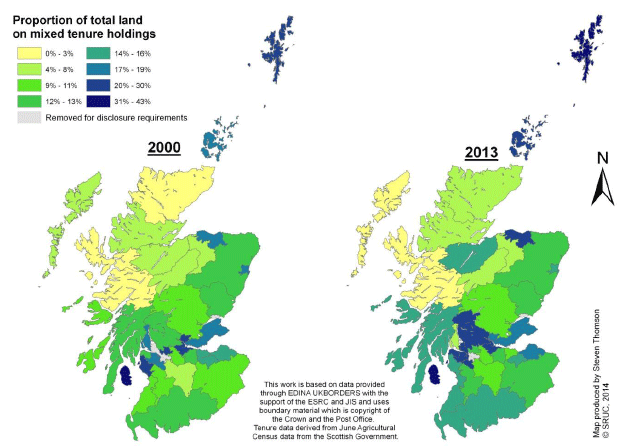
Types of Tenure Arrangements
4.17 Since 2005 the Scottish Government has been gathering data on the type of tenure arrangements holdings have, collecting details about:
- Small Landholders Act tenancy. The Small Landholders (Scotland) Act 1911 to encourage the creation of small agricultural holdings outwith Scotland's crofting counties. These are similar to crofting leases and landlords are required to inform the Scottish Government where a successor cannot be found and the landlord may be restricted from re-letting the holding without the Scottish Government's approval to any person other than a neighbouring holder to enlarge his holding or to a new holder. If a new landholder cannot be found the Scottish Government may allow landlords to let the land under another form of land tenure.
- 91 Act tenancy. The 1991 Agricultural holdings (Scotland) Act 1991 consolidated legislation from over a century regarding leasing of land for agricultural purposes. It regulates lease terms (including fixed equipment obligations by landlords and rent reviews, notices to quit, etc), provides general security of tenure to tenants, provides statutory rights to compensation for tenant improvements at waygo and deals with assignation rights and succession rights of near relatives of the tenant. Under the Agricultural Holdings (Scotland) Act 2003 tenants of 1991 Act leases have a right of pre-emption should the landlord sell, provided the tenant has registered their interest with the Scottish Government. Landlords and tenants can still enter 1991 Act tenure agreements providing the lease expressly states the 1991 Act applies to it.
- Limited Partnership tenancies. These tenancies were established to avoid security of tenure that 1991 Act leases provided. A limited partnership was established where the limited partner (the landlord) made an initial capital contribution but took no part in the management of the partnership affairs. The general partner (the tenant) had sole management responsibilities of the partnerships affairs and had rights to the bulk of the profits of the partnership. Security of tenure was avoided by the landlord granting a tenancy to the partnership (of which he was part) meaning that when the partnership dissolved (generally after a fixed period) the tenancy would no longer exist. The 2003 Act sought to protect general partners from notices to quit through termination of the partnership and now provide the general partner a further three years tenancy after the termination of the limited partnership provided they serve a counter notice to the limited partner (landlord).
- Limited Duration Tenancy (LDT). These were introduced by the Agricultural Holdings (Scotland) Act 2003 and were originally set for a minimum period of 15 years until the Public Services Reform (Agricultural Holdings) (Scotland) Order 2011 reduced the minimum term to 10 years. Tenants with LDTs have rights of assignation and succession for the term of the lease and the tenant has rights to compensation for improvements at waygo.
- Short Limited Duration Tenancy (SLDT). These were introduced by the Agricultural Holdings (Scotland) Act 2003. They are for between one and five years duration. If the tenant of a lease of less than 5 years continues to occupy the land after the tenancy period has ended it automatically extends to 5 years. Should the tenant continue to occupy the land beyond 5 years then the lease reverts to a Limited Duration Tenancy of 10 years (the Public Services Reform (Agricultural Holdings) (Scotland) Order 2011 introduced an opportunity for landlords and tenants to agree a conversion of a SLDT to LDT with an effective start date of the period when the SLDT started). Tenants with SLDTs are entitled to compensation for improvements at waygo and succession rights for the duration of the lease.
4.18 The estimated number of holdings (excluding crofts) with different lease types and the area leased are summarised in Figure 14 and Figure 17 (with data provided in Table 19 in Annex A).
1991 Act Tenancies
4.19 Figure 14 shows the rented area and number of holdings that reported, and are estimated[8] to have secure 1991 Act leases. It is evident from this graphic that whilst both the number of holdings and area that are estimated to be under secure 1991 Act leases were in decline the area and number of holdings reporting 1991 Act tenancies have been increasing. This is likely to be due to reporting lags from the JAC, where forms were returned incomplete or were not returned at all. Overall the estimated figures show that both the estimated area and number of holdings under secure 1991 Act leases has been in decline falling from 7,129 holdings with 1.15 million hectares in 2007 to 5,793 holdings and 0.887 million hectares. This represents estimated declines of 18.7% and 22.9% respectively.
Figure 14 Number of holdings and area under secure 1991 Act lease, 2007[9]-2013
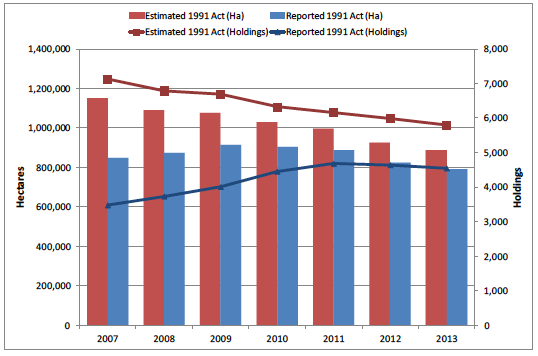
4.20 Figure 15 shows the change in the amount of holdings with 1991 Act leases has decreased generally at quite a steady rate across the regions, generally falling by about 15-20% over the 2007 to 2013 period with the largest percentage changes in Tayside (-21.1%), Clyde Valley (19.5%), Dumfries and Galloway (-19.5%) and Ayrshire (-19.3%). The amount of land leased under secure tenure fell by 250,066ha over the period and 43% of that change was from Highland, with Tayside accounting for further 20%, North East Scotland 9% and Dumfries and Galloway 8%.
Figure 15 Regional change in holdings with and area under 1991 Act leases, 2007-2013
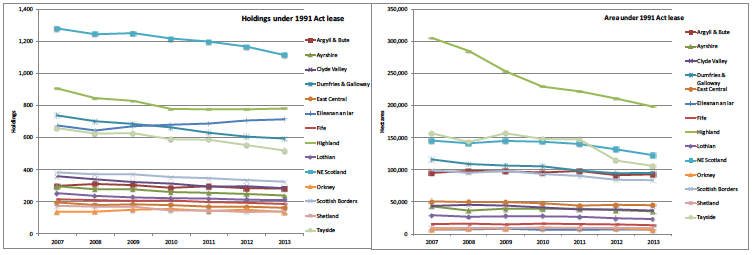
4.21 Figure 16 shows that North East Scotland accounted for 19.6% of the holdings with 1991 Act leases in 2013, with 14% of the area under secure tenancy. 13.7% of the holdings were located in Highland with 22.7% of the land with Tayside (9.1% holdings and 12.1% of land), Dumfries and Galloway (10.4% of holdings and 10.9% of land), Argyll and Bute (5% of holdings and 10.6% of land) and the Borders (5.7% of holdings and 9.5% of land) also being important locations for secure tenancies.
Figure 16 Regional distribution of area under and holdings with 1991 Act leases, 2013
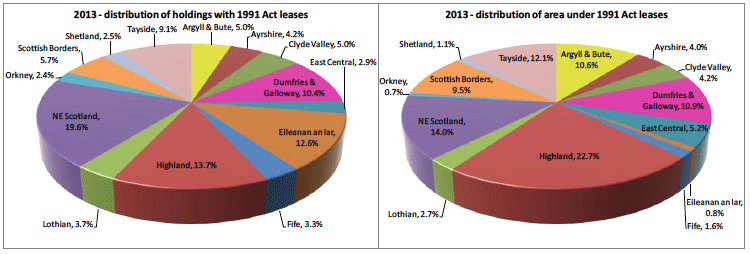
4.22 It was estimated that the number holdings with 1991 Act Ltd Partnership leases fell from around 635 in 2007 to 418 in 2013, with the area under this form of tenure also falling by 37% from 213,630ha to 134,593ha. The number of LDTs grew from an estimated 106 in 2007 to 292 in 2013 with area increasing by 49,000ha over that period. The number of estimated SLDTs nearly doubled, rising from 257 in 2007 to 508 in 2013 (with the area rented increasing by 71% to 87,000ha). There were very few Small Landholders Act Tenancies.
Figure 17 Number of holdings with and area of other tenancy arrangements: 2007-2013
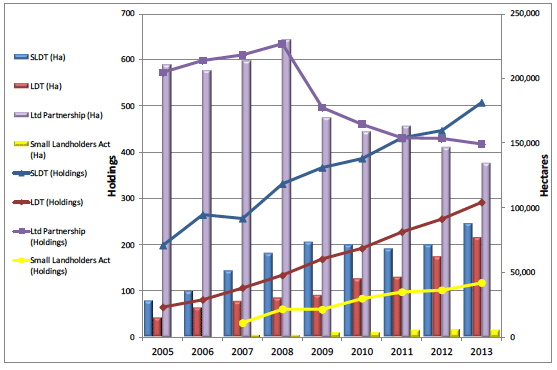
4.23 Examining the data at business (BRN) level shows that whilst 3,803 businesses recorded that they leased[10] 783,602ha under 1991 Act tenancies in 2013 it was estimated that there actually were 4,497 businesses renting 871,518ha. It was estimated that between 2009 and 2013 there was a 13% reduction in the number of businesses with secure leases with a 17.3% reduction in the area under 1991 Act leases. As with Figure 17, the reporting lag is apparent here as the number of BRNs that reported having secure leases increased over the period (despite a 13.5% decrease in reported area rented). There was a 34.7% increase in the number of SLDTs with a 19.3% increase in the area let under this method - although the increase in area solely took place in 2013. Whilst the number of LDTs showed a large percentage increase it must be acknowledged that it started at a very low base and was reported in the 2013 JAC that there were still only 272 businesses with LDT agreements. As discussed above the number of businesses with Ltd Partnership continued to fall with an estimated 378 with 134,000ha in 2013.
Table 7 Number of BRNs with, and area of, differing tenancy arrangements: 2009-2013
| Form of Tenure | 2009 | 2010 | 2011 | 2012 | 2013 | 2009-13 |
|---|---|---|---|---|---|---|
| Estimated 1991 Act | 5,171 | 4,865 | 4,761 | 4,661 | 4,497 | -13.0% |
| 1,054,357 | 1,004,248 | 971,127 | 908,390 | 871,518 | -17.3% | |
| Reported 1991 Act | 3,485 | 3,854 | 3,941 | 3,915 | 3,803 | 9.1% |
| 906,078 | 893,552 | 873,523 | 815,054 | 783,602 | -13.5% | |
| SLDT | 337 | 351 | 384 | 403 | 454 | 34.7% |
| 72,484 | 70,346 | 67,035 | 70,111 | 86,442 | 19.3% | |
| LDT | 160 | 179 | 212 | 243 | 274 | 71.3% |
| 31,852 | 44,082 | 45,305 | 61,468 | 76,076 | 138.8% | |
| Ltd Partnership | 456 | 422 | 388 | 391 | 378 | -17.1% |
| 167,854 | 158,913 | 156,487 | 146,464 | 134,015 | -20.2% |
Limited Duration Tenancies
4.24 Figure 18 shows that there has been a strong regional dimension to the growth in the number of LDTs with a quarter of them (71) existing in the North East in 2013, growing from only 13 in 2005. Dumfries and Galloway (39), the Borders (40), Highland (33) and Tayside (31) also have had faster uptake of LDTs as a form of tenure than the remaining regions. With regards to the area leased, the Highlands accounted for more than a quarter (27% or 20,000ha) of all land leased under LDTs in 2013, although this area more than doubled between 2012 and 2013. At nearly 13,000ha the Borders accounted for 17% of the area leased in 2013, with the North East and Dumfries and Galloway each accounting for 15% (about 11,500ha). Whilst these regions appear to have relatively fast uptake of LDTs as a form of tenure the number of holdings using them and the area let is dwarfed by the decrease in the number of holdings and area let through 1991 Act tenancies and 1991 Act Ltd Partnership tenancies over the period.
Figure 18 Number of holdings with and area rented through LDTs, by region: 2005-13
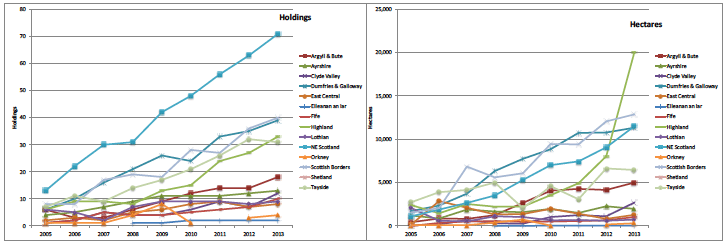
4.25 The uptake of LDTs was dominated by LFA Cattle and Sheep holdings which in 2013 accounted for 45% of all holdings with LDTs and 75% of the area let. It is interesting that whilst very small holdings accounted for most LDTs in 2013 (see Figure 30) there was relatively similar uptake in their use across all other size groupings. Very Large holdings accounted for nearly half the area rented under LDTs in 2013 at over 36,000ha with large holdings accounting for nearly 17,000ha (22%) of LDT leased land. Maps showing the spatial distribution of the area of land let through LDTs in 2007 and 2013 can be found in Figure 35 in Annex A).
Figure 19 Number of holdings with and area rented through LDTs, by size grouping: 2005-13

Short Limited Duration Tenancies
4.26 Figure 18 shows that once more the North East had the fastest uptake of SLDTs increasing from 45 in 2005 to 117 (23% of the total) in 2013. Dumfries and Galloway and Tayside (79 and 69 respectively in 2013) and Highland and the Borders (52 and 42 respectively in 2013) also had greater uptake of SLDTs than the other regions. The Highlands accounted for 28% of the total area let under SLDTs, although this took a sharp decline from 2009 before recovering in 2013. The North East (14%), Clyde Valley (12%), Argyll and Bute (10%) and Tayside (12%) accounted for the majority of the rest of land let through SLDTs in 2013.
Figure 20 Number of holdings with and area rented through SLDTs, by region: 2005-13
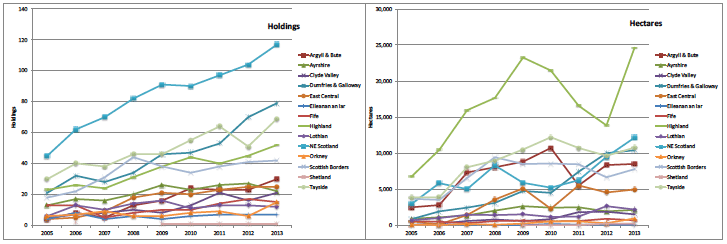
4.27 As with LDTs, the letting of land through SLDTs is dominated by the LFA cattle and sheep sectors, accounting for 44% of holdings and 77% of the total area let under SLDTs in 2013. Figure 21 shows that the SLDTs were more frequently used by very small holdings (36% of all holdings using SLDTs) in 2013, although the total area leased was limited (6,800ha). In 2013 over 65,000ha was leased using SLDTs by very large and large holdings (over 75% of total area). Maps showing the spatial distribution of the area of land let through SLDTs in 2007 and 2013 can be found in Figure 34 in Annex A).
Figure 21 Number of holdings with and area rented through SLDTs, by size grouping: 2005-13

Limited Partnership Tenancies
4.28 Figure 22 reveals the changes in the number of holdings, and area of land that was reported as leased through Limited (Ltd) Partnership tenancies. After 2008 there was a sudden drop in their frequency of use across many regions, particularly in the North East and Dumfries and Galloway. Whilst the Borders, Highland and Tayside also had a sharp decline in the number of holdings with Ltd Partnership tenancies they stabilised from 2010. It is clear that in the majority of regions the area let under Ltd Partnership agreements has continued to fall since 2005, with Highland decreasing by 60%, Tayside by 50% and Argyll and Bute by 45% etc.
Figure 22 Number of holdings with and area rented through Limited Partnership tenancies, by region: 2005-13
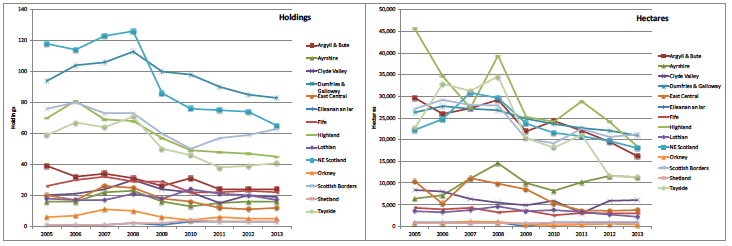
4.29 The vast majority of the reduction (74,000ha) in the area under Ltd Partnership agreements took place on LFA cattle and sheep holdings (they accounted for 80% of all area rented in both 2005 and 2013). Figure 23 shows how the change in holdings with Ltd Partnership tenancies decreased by similar proportions across all size groupings, although the biggest decrease (47%) in the area rented occurred on large holdings (29,000ha), with very large holdings having a smaller decrease (17,000ha) of only 18%. Maps showing the spatial distribution of the area of land let through LDTs in 2005 and 2013 can be found in Figure 36 in Annex A).
Figure 23 Number of holdings with and area rented through Limited Partnership tenancies, by region: 2005-13

Seasonally Let Land
4.30 Whilst there was a significant decline in the area of land let through traditional tenure arrangements between 2000 and 2013, there was, between 2005 and 2013 a significant uplift in the area of land let on a seasonal / temporary basis. According to IACS data there was 510,805ha of seasonally let land in 2005 (just after the introduction of the Single Farm Payment) and by 2013 this had reached 721,907ha. This equated to 13.5% of the total land on non-croft holdings.
4.31 Figure 24 shows the importance of rough grazing (RGR) in these seasonal lets accounting for 62% of the total in 2005 rising to 75% in 2013. Whilst there was only a slight decrease in the absolute area of seasonally let permanent grass (PGRS), it accounted for only 16.5% of total seasonally let in land in 2013 (from 27% in 2005). The area of temporary grassland (TGRS) and other land (mostly cropping) remained relatively stable over the period. The changes in seasonally let land related to (a) land let to "slipper farmers" and (b) land let to active farmers who were looking for additional eligible hectares to ensure they did not receive CAP penalties for having ineligible features on their land that could lead to an over-declaration of their eligible area compared to the number of SFP entitlements claimed (this is particularly the case following 2009 when SGRPID tightened up on ineligible features as a result of EU audit criticism).
Figure 24 Area of seasonally let-in land by land-use: 2000 - 2013
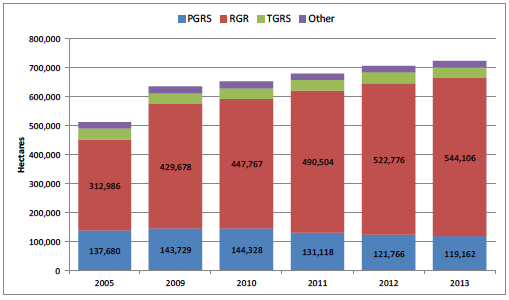
4.32 From the JAC the full timeline can be observed, and the regional dimension is particularly interesting. Figure 25 shows that the majority of the change in leased-out land was located in the Highlands, where there are large amounts of "naked acres" which "slipper farmers" and active farmers looking for some CAP safety-net can readily rent land on a seasonal basis. Whilst the seasonal rental land has largely been sourced from the Highlands since 2005 (40% of all seasonal let land in 2013), in 2013 holdings in the Highlands only let in the equivalent of 29% of the region's total seasonally let out hectares, meaning over 70% was rented-in by holdings in other regions.
Figure 25 Area of seasonally let-in and let-out land by region, 2000-2013 (JAC)
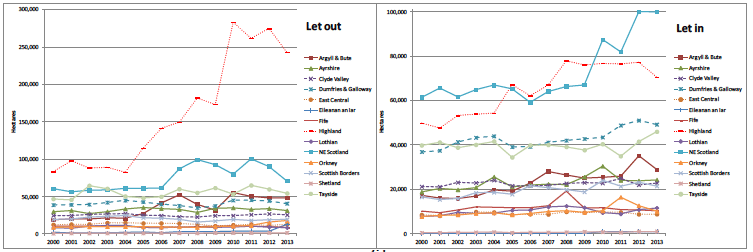
4.33 Examination of the parish level[11] data reveals that whilst there was a high level of rented in sasonal land around Lochaber in both 2005 and 2013 there was a general increase across most parishes in Scotland by 2013. Seasonally let-out land at local level particularly increased in the central Highlands and Wester Ross
Figure 26 Area of seasonally let-in and let-out land by NUTSIV region, 2005 and 2013 (from IACS)
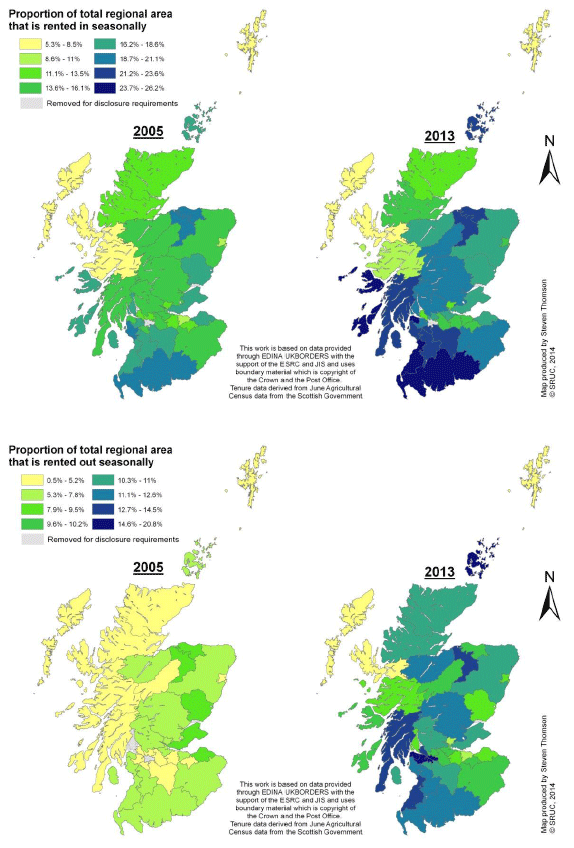
4.34 Figure 26 examines the geospatial nature of the seasonally let-in and let-out markets by showing the portion of land seasonally rented in (from within and from other regions) and of seasonally rented out (to those within the region and beyond) in both 2005 and 2013. Here the darker blue areas have the largest proportion of the region's area seasonally let. The top two maps reveal how the proportion of seasonally let-in land has increased across most areas with the exception of Shetland, the Western Isles, Lochaber, Skye and Lochalsh. The south west of Scotland is notably letting in over a quarter of the total land on holdings seasonally, with increases also in Argyll and Bute and Orkney. The lower two maps also reveal a step change in the proportion of land leased out seasonally between 2005 and 2013 with increases in most regions with the exceptions of Skye and Lochalsh, Tayside and East Lothian.
Register of Tenant Farmers' Interest in Land
4.35 Part 2 of the Agricultural Holdings (Scotland) Act 2003 provided tenant farmers pre-emptive rights to purchase their holding, should the land owner choose to sell the land. This right is only available to those secure (1991 Act) tenants who publically register their interest with the Government, through Registers of Scotland[12]. Using data extracted from the Register of Agricultural Tenants Interests (November 2013) and some analysis conducted by RESAS, Table 8 reveals the number of registered interests in agricultural units by county and the total area (where known) of those interests. 1,135 interests were registered[13] covering more than 190,000ha (with size of the land unknown in 14% of the cases) representing 21.5% of the estimated total area under secure 1991 Act leases in 2013. There is widespread uptake of the right geographically with some higher concentrations in counties traditionally associated with estate ownership and tenant farming.
Table 8 Location of Register of Agricultural Tenants Interests and area of land
| County | Units | Ha | Size unknown | County | Units | Ha | Size unknown |
|---|---|---|---|---|---|---|---|
| Aberdeen | 136 | 11,108 | 20 | Kircudbright | 32 | 5,123 | 5 |
| Angus | 80 | 10,149 | 12 | Lanark | 34 | 6,061 | 5 |
| Argyll | 61 | 23,047 | 11 | Midlothian | 40 | 6,279 | 4 |
| Ayr | 46 | 5,170 | 6 | Moray | 36 | 7,378 | 1 |
| Banff | 60 | 7,536 | 16 | Nairn | 20 | 2,686 | 1 |
| Berwick | 24 | 4,701 | 4 | Orkney | 8 | 831 | 1 |
| Bute | 15 | 3,989 | 2 | Peebles | 2 | 64 | |
| Caithness | 9 | 3,580 | 4 | Perth | 91 | 17,349 | 11 |
| Clackmannan | 4 | 41 | 2 | Renfrew | 23 | 2,810 | 1 |
| Dumbarton | 8 | 187 | 3 | Ross and Cromarty | 30 | 2,620 | 5 |
| Dumfries | 70 | 9,225 | 7 | Roxburgh | 54 | 13,749 | 4 |
| East Lothian | 18 | 3,095 | 4 | Selkirk | 13 | 5,753 | 3 |
| Fife | 70 | 6,526 | 6 | Stirling | 24 | 6,307 | 3 |
| Glasgow | 3 | 167 | Sutherland | 10 | 2,363 | 4 | |
| Inverness | 40 | 9,741 | 6 | West Lothian | 8 | 665 | |
| Kincardine | 26 | 1,570 | 5 | Wigtown | 38 | 9,190 | 1 |
| Kinross | 2 | 3 | 1 | Scotland | 1,135 | 189,061 | 158 |
4.36 It is of particular note that when scrutinising the register that the word "glebe" appears often and analysis shown in Table 9 reveals that the Church of Scotland (or variants of in the register) was the landowner in 54 cases, accounting for 1,775ha. The Crown Estate had 54 registers of interest in land they let out. Buccleuch Estates were the private land owner with the most registers of interest (30 and 9,511ha) followed by Seafield Estates (19 and 1,782ha).
Table 9 Significant landowners in the Register of Agricultural Tenants Interests, December 2013
| Landowner | Units | Ha |
|---|---|---|
| Church of Scotland | 54 | 1,775 |
| Crown Estate | 54 | 8,482 |
| Buccleuch Estates Limited | 30 | 9,511 |
| Earl of Seafield | 19 | 1,782 |
| Islay Estates Company | 18 | 4,377 |
| Scottish Water | 15 | 4,395 |
| Earl of Stair | 11 | 4,650 |
| Mount Stuart Trust | 11 | 2,050 |
| Baron Lyell of Kinnordy | 10 | 735 |
| Wemyss Estate Trust | 10 | 896 |
4.37 Figure 27 shows the location of all the land that is included on the register (as of December 2013). This was overlaid on a map showing proportion of land let under tenancy arrangements. It is perhaps notable that there were higher concentrations of registration in the more fertile regions (Moray, Black Isle, Berwickshire, Wigtownshire, Lothians, Tayside, etc) with very little from the majority of the west and central Highlands, and the Islands (with the exception of Islay) where Community ownership of land is more prevalent.
Figure 27 Location of land on the Register of Agricultural Tenants Interests (Dec, 2013)
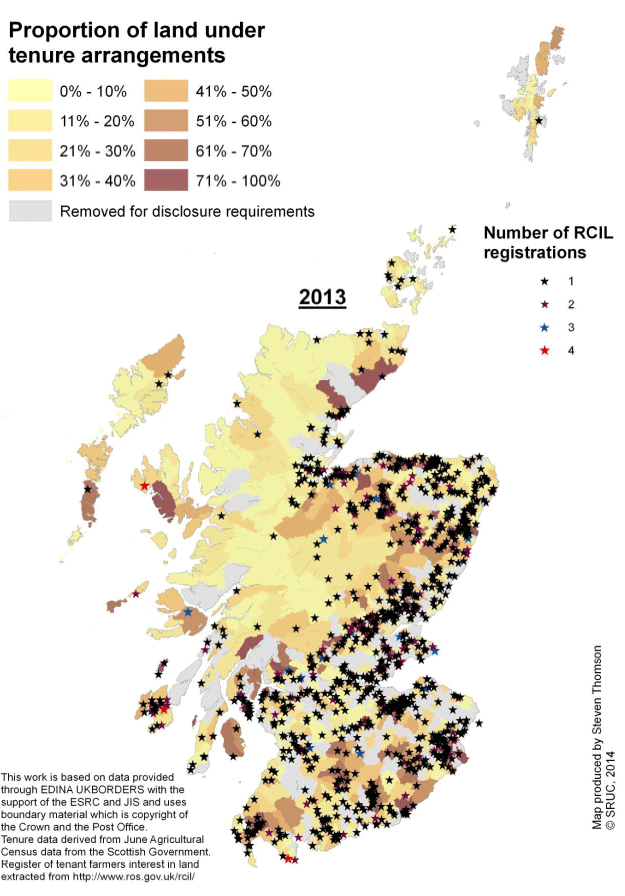
Contact
Email: Angela Morgan
There is a problem
Thanks for your feedback